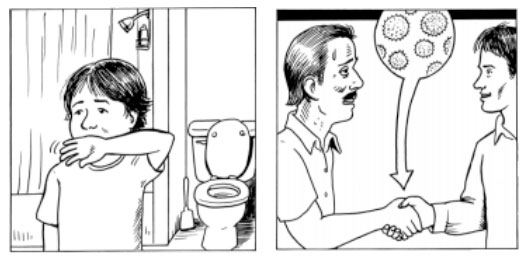Norovirus 101: Older People are at Higher Risk

Norovirus is very contagious. It can easily spread in closed indoor settings with large populations, including nursing homes, assisted living facilities, and healthcare settings. While norovirus doesn’t typically have serious consequences, older people are at higher risk for complications—mainly dehydration.
Read on to learn more about norovirus and how you can help prevent its spread.
If you’ve been following local news in recent weeks, you may have seen stories about outbreaks of norovirus – a highly contagious virus that causes rapid onset of vomiting and diarrhea.
Norovirus is the most common cause of acute, or short-term, gastroenteritis (inflammation of the stomach and intestines) in the country and is responsible for approximately 20 million illnesses each year. It’s also the leading cause of foodborne illness in the United States. It’s present year-round, but most outbreaks occur during November to April, when people are more regularly in close quarters indoors. In fact, it’s so common in the winter that it used to be called “winter vomiting disease.”
Symptoms
Symptoms of norovirus usually begin about 12–48 hours after exposure to the virus and typically last for one to three days.
The most common symptoms are:
- Nausea
- Vomiting
- Stomach cramps
- Diarrhea
Other symptoms include:
- Fever
- Headache
- Body aches
According to Dr. Meagan Kay, medical epidemiologist at Public Health—Seattle & King County, “Norovirus, while very unpleasant when you’re sick, does not typically have serious consequences for otherwise healthy children and adults.” Dehydration from frequent vomiting and diarrhea is the most common complication, particularly among young children and the elderly.
“If you’re sick with norovirus-like illness, drink plenty of liquids to replace lost fluids,” said Kay. Sports drinks and other drinks without caffeine or alcohol can help with mild dehydration. But, these drinks may not replace important nutrients and minerals. Oral rehydration fluids that you can get over-the-counter are most helpful for mild dehydration.
How norovirus spreads
Norovirus is highly contagious, and people with norovirus infection are most likely to spread it from the moment they feel ill until at least three days after they no longer have symptoms. The virus can live on surfaces for days or even weeks, which is why it is so easy for outbreaks to occur in indoor settings where people are in close contact, such as schools, healthcare facilities, and restaurants.
Common ways people get norovirus:
- Close contact with an infected person (such as caring for someone who is sick with norovirus).
- Touching surfaces and objects that are contaminated with norovirus and then putting your fingers in your mouth.
- Eating foods or drinking liquids that are contaminated with the virus.
“Unfortunately, there are many different types of norovirus,” explained Kay. “So, just because you’ve had norovirus once doesn’t mean you can’t get sick with it again.”

Norovirus leaves the body through feces and vomit, and spreads easily, especially if it gets on someone’s hands. For more info, check out our illustrated norovirus factsheets, available in multiple languages.
Prevention
The best way to protect yourself and others from norovirus is to wash your hands with soap and water frequently. Even after someone’s norovirus symptoms have stopped, the virus can stay in their body for two weeks or more, so it’s good to be extra diligent about hand washing during that time.
Millions of norovirus particles are in the vomit or diarrhea of someone who’s sick from the virus, so it’s important to quickly clean and disinfect any areas where someone has vomited or had diarrhea. Typical household cleaning products don’t kill norovirus. In order to disinfect surfaces potentially contaminated with norovirus, use a solution of bleach and water. For more information, see our step by step instructions for how to clean and disinfect following incidents of vomiting and diarrhea.
Finally, norovirus can live for long periods of time on food. Therefore, always wash fruits and vegetables and be sure to fully cook meat, poultry, and fish including shellfish, as this will kill norovirus and other potential contaminants.
Public Health’s role
Individual cases of norovirus are not “reportable,” like measles or pertussis cases, which healthcare providers are required to report to Public Health; however, outbreaks of norovirus in institutions (for example, schools, long-term care facilities, and healthcare facilities) are reportable.
When we learn of outbreaks of possible norovirus, we collect information about symptoms, how long symptoms last, and how quickly the disease is spreading to determine if the outbreak is likely norovirus or something more serious. Laboratory testing to confirm norovirus is not done commonly because most people recover quickly.
We also look for a single source of infection, such as contaminated food or an ill food worker. In most norovirus outbreaks, there isn’t a single source of infection; it’s common for the virus to spread person to person. In these cases, we provide cleaning and disinfection guidance for the institution to help prevent the outbreak from spreading further.
For more information on how we investigate potential norovirus outbreaks, click here.
For more information about norovirus, and how to differentiate norovirus from the flu, visit Public Health’s norovirus webpage.
Contributor Kate Cole is a communications specialist at Public Health—Seattle & King County.
![AgeWise King County [logo]](https://www.agewisekingcounty.org/wp-content/themes/agewisekingcounty/images/logo.png)